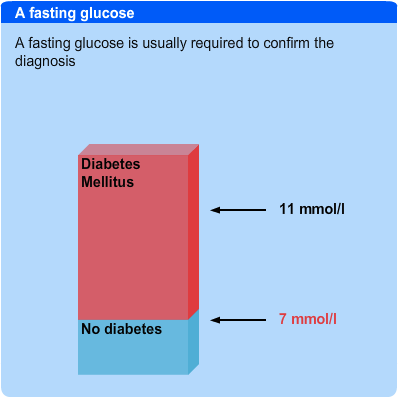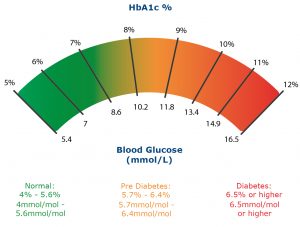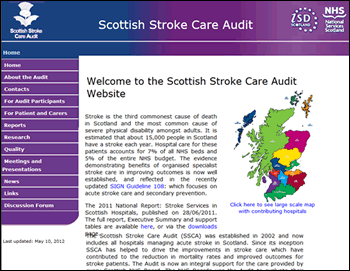- 80-85% of people with type 2 diabetes are overweight
- Being overweight reduces the body’s ability to respond to insulin, so called ‘insulin resistance’
- Those at greatest risk:
- Women > 80 cm (31.5 inches).
- Men > 94cm (37 inches)
- South Asia, African-Caribbean Men > 90cm (35.5 inches)
Category: Topic Loops
Diabetes
- 1 in 3 non diabetics will have an increased glucose during their acute stroke
- Diabetes is an independent risk factor for ischaemic stroke; the risk of having a stroke is 2-3 x higher in people with diabetes
- Research on animals show that preventing hyperglycaemia reduces ischaemic damage in stroke
- Long term outcomes such as functional recovery and 5 year mortality are poorer in those with diabetes
- Risk factors for developing diabetes include obesity, family history, lack of physical activity, being of Afro-Caribbean or South Asian origin
- Type II diabetes carries a higher risk of stroke than Type I diabetes because of a greater frequency of other risk factors such as obesity, hyperlipidaemia and hypertension
Diabetes management following stroke
Introduction to diabetes
To diagnose diabetes accurately one needs to understand the glucose levels that are associated with impaired glucose tolerance and diabetes as shown in the diagrams:


Stroke ‘Local Development Plans’
Local Development Plans relate to stroke care in all Health Boards across NHS Scotland. The plans are developed to improve stroke care and take into account local variations in services available while still being linked to the annual national stroke care audit.
What are Local Development Plans?
Local Development Plans are measures for NHS Scotland Health Boards. The plans are set each year after consultation with stakeholders and cover a variety of areas. Progress is measured throughout the year and NHS Boards are held to account during annual stroke care audit.
The main areas include:
- improving health and life expectancy
- continuously improving the effectiveness and efficiency of the NHS in Scotland
- recognising patients’ need for quicker and easier use of NHS services; and
- ensuring patients receive high quality services that meet their needs
Scottish Stroke Care Standards
| Topic | Current Scottish Stroke Care Standards (2021) |
|---|---|
| Access to stroke unit | 90% of all patients admitted to hospital with a diagnosis of stroke are admitted to the stroke unit on the day of admission (day 0), or the day following presentation at hospital (day1), and remain in specialist stroke care until in-hospital stroke-related needs are met. |
| Brain imaging | 90% of patients have CT/ MRI imaging within 12 hours of admission unless there is a documented contraindication. |
| Swallow screen | 100% of patients are screened by a standardised assessment method to identify any difficulty swallowing safely due to low conscious level and/ or the presence of signs of dysphagia within 4 hours of arrival at hospital before the patient is given any food/ drink or oral medication. The result of the screen/ test should be clearly documented in the patients’ notes. |
| Aspirin prescribing | 95% of patients in whom a haemorrhagic stroke has been excluded, or other contraindication, as specified in the national audit, are given aspirin on the day of admission (day 0) or the following day (day 1). |
| Delay from receipt of referral to specialist neurovascular clinic | 80% of new patients with a stroke or TIA are seen within 4 days of receipt of referral to the neurovascular clinic. (Day 0 being day of receipt of referral). |
| Thrombolysis | Managed Clinical Networks (MCNs) monitor the delay between arrival at the first hospital and administration of the bolus of recombinant plasminogen activator. 50% of patients receive the bolus within 30 mins of arrival.
80% of patients receive the bolus within one hour of arrival. |
| Early carotid intervention | 80% undergoing carotid endarterectomy for symptomatic carotid stenosis have the operation within 14 days of the event that first led them to seek medical assistance. |
| Scottish Stroke Care Bundle
|
80% of all patients admitted to hospital with a diagnosis of stroke should receive the appropriate elements of the stroke care bundle.
The key elements of the stroke care bundle are: 1. Admission to the stroke unit on the day of admission, or the day following presentation at hospital; 2. Screening by a standardised assessment method to identify any difficulty swallowing safely due to low conscious level and/ or the presence of signs of dysphagia within 4 hours of arrival at hospital; 3. CT/ MRI imaging within 12 hours of admission; and 4. Aspirin is given on the day of admission or the following day where haemorrhagic stroke has been excluded, or other contraindication, as specified in the national audit. The current Scottish Stroke Care Standards are available to access here.
|
Clinical standards
What are the Clinical Standards for Stroke Care in Scotland?
Scottish Stroke Care Standards
NHS Quality Improvement Scotland (NHS QIS) produced clinical standards for Stroke Services in March 2004. Scotland’s action plan for health and wellbeing Better Health, Better Care highlighted stroke as a national clinical priority. These standards were revised in June 2009 following publication of SIGN 108 in December 2008.
The NHS QIS standards focus on those parameters which have the best evidence for having an effect on patient outcomes, e.g. stroke unit care, swallow screening, brain imaging, acute aspirin use, delays to assessment in specialist neurovascular clinics, delivery of thrombolysis and early carotid intervention.
In 2012 the National Advisory Committee for Stroke (NACS) at the Scottish Government the Scottish Stroke Care Audit (SSCA) Steering Committee reviewed the current NHS QIS Standards for Stroke Care (June 2009) in collaboration with Scottish Stroke Managed Clinical Networks (MCN) and colleagues in the wider Scottish stroke community.
The proposed Scottish Stroke Care Standards were agreed, and implemented on 1st January 2013. These standards are now reviewed on an annual basis.
The current Scottish Stroke Care Standards are available to access here. More details are available on the next page.
SSCA reports
Monthly reports provide MCNs with up to date information on monthly and quarterly performance against the national standards for stroke care. They present 12 months of data on one chart in addition to the previous two years performance. This allows the MCNs to monitor trends in performance.
Monthly reports should be used locally to monitor current performance, highlight areas requiring improvement and influence change.
The annual national report contains information on individual hospitals, Board areas and Scotland as a whole. The annual national report is a public document. Again the MCNs disseminate to appropriate personnel within their Boards, e.g. Board members, ward teams and patient/ carer representatives. This document is also shared with the Scottish Government and Chief Executives within NHS Boards.
Further information regarding SSCA and previous copies of the annual national reports can be found at the Scottish Stroke Care Audit website.
More about the Scottish Stroke Care Audit (SSCA)
What is the Scottish Stroke Care Audit (SSCA)?
The SSCA started collecting information about stroke care in 2002 and now includes all hospitals managing acute stroke in Scotland. Since its inception SSCA has helped to drive the improvements in stroke care which have contributed to the lower mortality rates and improved outcomes for stroke patients.
The SSCA collects a variety of information about stroke care however, the main purpose of the audit is to monitor performance against national standards and criteria.
Data are collected relating to the following groups of patients:
- Patients admitted to hospital with a stroke (inpatients)
- Patients seen in ambulatory care settings (TIA clinics, Emergency dept, Ward attendees)
- Patients receiving hyper-acute treatment with thrombolysis or thrombectomy
- Patients undergoing carotid intervention
Detailed criteria for assessing the quality and availability of stroke rehabilitation are available, and annual organisational audits determine whether comprehensive stroke services across the whole patient pathway are available in each NHS Board.
SSCA produces monthly and annual reports:
The monthly reports contain only information pertinent to individual Board areas. They are shared with stroke Managed Clinical Networks (MCNs) who disseminate them to appropriate personnel within their Boards, for example Board members, service managers, planners and ward teams.
Clinical audit
What is Clinical Audit?
Clinical audit is the process used by health professionals to assess, evaluate and improve the care of patients in a systematic way in order to enhance their health and quality of life. It consists of four basic steps which are summarised in the diagram below:
Ref: Making Sense of Audit, D & S Irving, Radcliffe Medical Press, 1991, p16



